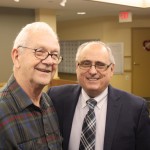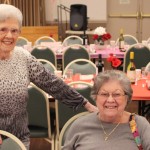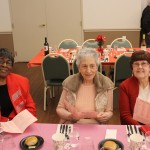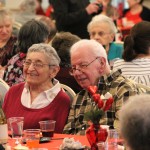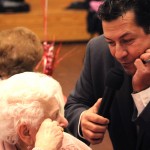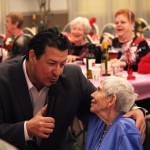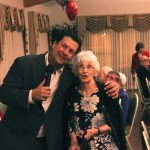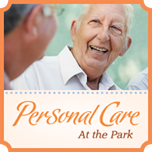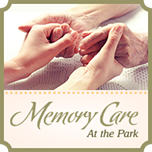Memory Care I
- 2:00 P.M. – Mother’s Day Facts
Memory Care II
- 1:45 P.M. – Mother’s Day Facts
My mother and grandmother was a resident at The Park from July 2018 until February 2019. She had been in an assisted living facility near Danville, PA for the prior three years. The assisted living experience was not great but tolerable. So we had some reservations about any senior care facility when it came time for us to transition from assisted living to skilled care. The timing of the transition made it even more difficult and added pressures to find the right place for her. My niece and I were very questioning and discerning during the initial tour and interviewing process. We were uneasy with moving my mother considering the distance and unknowns about the new home.
Michele D. handled us in the most professional way and assured us that she would be taken care of in the most caring way. Gloria Dei more than cared for my mother. They loved and took care of her in a way that made all of us feel as though we were one of their own family. Facing end of life circumstances is never easy for the ones we love. We are grateful that our mother and grandmother could be in the presence of love, grace and dignity that was provided by Gloria Dei. We thank all those that helped her and us during this time.
Sincerely,
Steve Maliesky and Jill Levan Davis
If you’ve noticed that your vision is becoming a little cloudy or that a cloudy film is beginning to cover a loved one’s eye, this very well could be the start of a cataract. Since age is the number one factor determining this condition, it’s quite common in the senior community. This is because, as we age, the eye’s lens gradually changes and becomes less transparent. According to the National Eye Institute, by age 80, more than half of all Americans either have a cataract or have opted for cataract surgery. So, what causes cataracts, how is vision affected, and what treatment options are available? Read below to learn more!
What Causes a Cataract?
Proteins in the eye’s lens must be arranged in a specific way in order to keep the lens clear. Unfortunately, age causes some of those proteins to clump, forming a cataract on a small part of the lens. Over time, cataracts can grow larger and cloud an increasing portion of the lens. Physicians don’t know why the eye’s lens changes with aging, but several factors other than aging are thought to cause cataracts, too. They include:
- Diabetes
- Eye trauma
- Medications
- Smoking
- Previous eye surgeries
Your Vision with Cataracts
In order to see, light must pass through the lens of the eye, which is located behind the iris and the pupil. A healthy lens is clear and able to change shape, allowing light to easily pass through to the retina. However, as we get older, the lens simply doesn’t work as effectively as it had previously. When the cells of the lens change, it begins to take on a cloudy appearance. This is known as a cataract. With a layer of cloudiness covering the lens, light can no longer pass directly through and vision problems begin to develop. These issues can occur in one eye or both, but cataracts do not spread from one eye to the other. They aren’t infectious.
Symptoms of Cataracts
The most common symptoms of a cataract are:
- Cloudy or blurry vision
- Colors appear dull
- Sensitivity to light
- Seeing a halo around light sources
- Double vision
Treatment for Cataracts
When cataract symptoms appear, seniors might be able to temporarily improve their vision using new glasses, magnifying glasses, brighter lighting, or doctor recommended visual aid tools. However, when cataracts progress and create serious vision problems, surgery is the only effective treatment. Not to worry, though. It is the most commonly performed surgery in the US, with over 3 million patients undergoing the procedure each year. It’s quite common and highly effective. During the surgery, skilled ophthalmologists simply remove the cloudy lens and replace it with an artificial lens implant instantly improving one’s vision. If you or a senior loved one are beginning to develop these specific signs and symptoms of cataracts, it might be best to see the eye doctor. He or she can recommend the proper next steps to ensure healthy vision for years to come!
It is widely known that the 65 and older age group is at a much higher risk to develop severe complications from the influenza virus. Between 50% and 60% of hospital stays from the flu and its complications occur within this senior group in the United States. This is due to weakening immune systems as individuals age. This turns any disease into a serious threat, especially the flu.
Luckily, there are several preventative measures that seniors and their loved ones can take to combat the flu season. However, these preventative measure are not a surefire way to make sure you or a loved one remain untouched by the flu. If anyone you know presents with flu like symptoms, they should immediately consult a healthcare professional.
Influenza Vaccines
The first step in preventing the flu is to make sure you and your loved one receive flu vaccines. Again, the immune system begins to weaken as we age, and individuals become extremely vulnerable to the flu virus. It’s crucial to encourage those aged 65 or older receive their flu vaccines. There are currently two options for this. One vaccine is a normal dose and the other is considered a high does flu vaccine. You can read more about them here.
It is important to consult a medical professional when deciding which is best. Most communities have flu vaccines available around the month of October. The best bet is to get it as soon as possible.
Practice Proper Hygiene
Everyone needs to practice proper hygiene, but especially your aging loved one, as well as yourself. Even though you might not feel sick, you may still carry germs that can then be transported to your loved one. Keeping proper hygiene is one of the single most effective ways to combat flu season.
- Wash your hands – It is extremely important to keep hands clean. This may be done with soap and warm water. Wash the hands for at least 20 to 30 seconds before rinsing. Be sure to dry with a clean cloth afterwards. If there is no soap and/or water present, use an alcohol based
hand sanitizer. - Cover your nose and mouth – Cover the nose and mouth every time a cough or sneeze threatens, if possible. Cleanse or sanitize hands immediately after each and every sneeze or cough.
- Don’t touch your eyes or mouth – Try to make a conscious habit of not touching any of the orifices of the face. This include the eyes. They’re a direct path for pathogens to enter your body.
- Keep countertops sanitized – This is especially important if anyone present is sick. Try your best to keep all surfaces in all rooms clean.
- Wash clothes and towels – Wash your cloths and towels on a regular basis. It’s also a good idea to wash bathing items and clothes used by sick individuals immediately after use, as well at keeping the sheets and pillow cases clean.
- Avoid sick individuals – Do not allows persons to visit until they are fully recovered to prevent the flu from spreading. Small children often are not old enough to be completely conscious of good hygiene habits and may spread the virus unintentionally.
These are some of the steps you can take to help your loved one remain healthy throughout flu season. We would like to reiterate that it’s not going to guarantee you that they remain unscathed for all of winter. However, it will greatly reduce their chances!
Diabetes is a metabolic disease that affects one in ten Americans. However, another 84 million individuals are at high risk of getting this disease, according to Health.gov. This seems to be a health epidemic that needs to be solved or stopped. Yet, it already has or at least can be. In order to reverse symptoms of type 2 diabetes, your diet will play an important role.
It is important to note that Type 2 Diabetes is an ongoing disease. You may no longer need to take medicine to control your blood sugar levels, due to a good diet and exercise (which is great), but that doesn’t mean the symptoms will never come back. You still need to monitor yourself. But it is entirely possible for some people to go years without the trouble of controlling their glucose and all the health concerns that come with diabetes. So how can you do it? Read below to take back control of your diet.
Here are some things you should avoid, as well as some things you should include in your diet.
To Avoid
Here are some suggestions of items that should be eliminated or limited in the diet of a loved one who has diabetes. This does not mean you need to rummage through your cupboards and remove every grain of sugar you find. However, it is important to to pay attention to the amount your loved one in consuming.
- Fat – Fat found in oils has little immediate effect on blood glucose levels. However, eating a fatty meal can slow down digestion and make it harder for your insulin to work, creating the possibility of high blood glucose levels hours after your meal.
- Salt – Although salt does not affect blood glucose levels, it’s important to limit the amount you eat as part of your diabetes management. Too much salt can raise your blood pressure, which people with diabetes are more likely to be affected by high blood pressure. This, in turn, increases the risk of heart disease, stroke, and kidney disease.
- Sugar – Sugar consumption will not directly cause Type 2 Diabetes. However, excess sugar consumption can cause weight gain, which then increases the risk of diabetes. Once a person has diabetes, eating too much sugar can make symptoms worse, since diabetes makes it more difficult for the body to manage blood sugar levels.
- Alcohol – If you have diabetes, drinking alcohol may cause your blood sugar to either rise or fall. Plus, alcohol has a lot of calories. If you drink, do it occasionally and only when your diabetes and blood sugar level are well-controlled.
To Include
Again, these suggestions should not be the only things included in your loved one’s diet, if they happen to have diabetes. Fats and sweets can be important to one’s diet. They wouldn’t be featured on the Food Pyramid if it wasn’t. But the amount consumed does need to be monitored. Here are some things that should be featured more in your loved one’s diet.
- Omega 3 Fatty Acids – Salmon, sardines, herring, anchovies, and mackerel are great sources of the omega-3 fatty acids, which have major benefits for heart health. Getting enough of these fats on a regular basis is especially important for diabetics, who have an increased risk of heart disease and stroke
- Leafy Greens – Leafy green vegetables are extremely nutritious and low in calories. They’re also very low in digestible carbs, which can raise your blood sugar levels. Spinach, kale, and other leafy greens are good sources of several vitamins and minerals, including vitamin C, which is known to lower inflammation in the body.
- Nuts – Nuts are delicious and nutritious. All types of nuts contain fiber and are low in digestible carbs, although some have more than others. Research on a variety of different nuts has shown that regular consumption may reduce inflammation and lower blood sugar.
- Broccoli – Broccoli is one of the most nutritious vegetables around. A half cup of cooked broccoli contains only 27 calories and 3 grams of digestible carbs, along with important nutrients like vitamin C. Studies in diabetics have found that broccoli may help lower insulin levels and protect cells from harmful free radicals produced during metabolism.
November is an important month as it is home to Alzheimer’s Awareness Month. Even though this particular type of dementia gets its own 30-day observance, it’s also important to understand the other forms of dementia. It represents a large number of neurological disorders and is NOT synonymous with Alzheimer’s disease. However, the major symptom they all have in common is a steady decline in brain function.
Though there are over 100 diseases thought to either cause or contribute to dementia, three are considered among the most common. Since seniors make up the largest portion of dementia diagnosis, having knowledge of the diseases can help those with aging loved ones who are experiencing a decline in brain function.
Alzheimer’s Disease
Alzheimer’s disease is by far the most common form of dementia. To truly grasp how common it is, here are some stats:
- Alzheimer’s makes up an estimated 50-70% of all dementias combined
- It affects one in four people over 85
- Increasing age is the biggest risk factor for Alzheimer’s
When diagnosed with this form of dementia, seniors can experience impaired memory, clouded thinking and violent mood swings.
There are two types of Alzheimer’s disease: sporadic or familial.
Sporadic Alzheimer’s disease: This type of dementia is the most common form of Alzheimer’s disease. It can affect adults of any age, but normally presents after the age of 65 and eventually requires some form of eldercare.
Familial Alzheimer’s disease: This form of dementia is rare and genetic. The disease itself if caused by an abnormal mutation in one of several genes. Once a mutated gene is detected, the patient will develop Alzheimer’s disease at some point, usually between the ages of 40 and 50.
Vascular Dementia
The second most commonly diagnosed form of dementia is vascular. This broad term refers to problems with blood circulation to and from the brain. There are a number of different types of vascular dementia, but the most common type is known as multi-infarct dementia. This form of vascular dementia is caused by a series of small strokes, also known as mini-strokes or Transient Ischemic Attacks (TIA). Multi-infarct dementia usually affects older adults between the ages of 60 and 75, with men being at a slightly higher risk for developing the disease. It is also possible for a senior to have both multi-infarct dementia and Alzheimer’s disease, making it extremely difficult for a doctor to diagnose either.
Lewy Body Disease
Lewy body disease is the third most common form of dementia, and it is possible that you’ve never heard of it before. However, LBD is not a rare disease. It affects an estimated 1.4 million individuals in the United States. Unfortunately, LBD symptoms can closely resemble other more commonly known diseases like Alzheimer’s and Parkinson’s, it is currently widely under-diagnosed.
This condition is caused by degeneration and death of vital nerve cells within the brain. Abnormal spherical structures, referred to as “Lewy bodies,” develop inside the brain’s nerve cells and slowly contribute to their death. A complex disease, LBD can present with a range of symptoms including problems with thinking, memory, moving, sleep and/or changes in behavior, to name a few of the physical, cognitive, and behavioral symptoms. Sadly, the cause of this disease is not well understood. Research continues, though hoping to provide an answer and a solution to this form of dementia.
There are many different ways to remain active as you age. However, there aren’t too many activities that can benefit your physical, mental, and spiritual self. The one activity that can is yoga. Read more about it below.
Of course, by now you’ve probably read about all of the benefits derived from yoga. It increases one’s flexibility, balance, and can even reduce stress levels. What’s not to like?! With that being said, it can be a little intimidating, picturing yourself attempting to balance on your head. Or locked in a pose the best resembles a pretzel. Luckily, you don’t need to fret about that. There are plenty of different types of yoga that involve different poses for people with different skill sets. Some are for advanced practitioners, while others are for those who are just starting out!
One of the best types of yoga for those who are just starting out is called Ansuara. Its translation means, “following your heart” or “flowing with grace.” It’s the perfect workout for someone just trying out their first yoga session. With environments that are non-competitive and poses that focus on body alignment, you won’t stress about performing impossible poses or holding up the class. The idea is to flow at your own pace, which is a great theme for any aging adult, since our joints become less fluid as we age. With the practice of Ansuara yoga, older adults can really stretch out those joints and get their blood flowing to all parts of their body.
No Strain. All Gain.
Exercise is an essential aspect of healthy aging, although cardio workouts and weight training can cause unwanted strain on our bodies. However, by doing yoga, you’re using your own body weight in different poses. Therefore, you’re making it less likely to injure yourself. You’re getting all of the gains without placing unnecessary strains on your muscles and joints.
Stretch and Flex
A lot of the poses performed in yogic practices not only strengthen muscles, but stretches them out at as well. This creates a greater range of motion and ultimately increases flexibility. A nimble body reduces the chances of falling down. That means more time on a yoga mat equates to less time or less of a possibility at the doctor’s office or hospital.
More Effective than a Glass of Milk
Studies show that not only does yoga slow down the process of osteoporosis, the degeneration of bone mass and density, but it also reverses it. Seniors who performed yoga for up to 2 years did not lose any bone density, and in fact, gained some back. That is because you hold the weight of your body up against gravity. Resisting gravity puts a mild stress on the bones. That stress forces bones into laying down new growth. In this way, yoga is no different from jogging, walking, or playing tennis.
The positive benefits are there! Yoga is not just some new trending fad that all of the young people are doing these days. It’s a fantastic workout that helps your muscles, bones, and mind. Don’t let intimidation be a factor. Take a class starting today!
We’d like to give a big “Thank you!” to everyone who helped make the 20th Anniversary of the Estates such a big success. It takes a lot of work from everybody including community leaders, corporate leaders, and the residents for an event like this to take place, and we can’t thank everyone enough! At Gloria Dei, you really are a part of a community and a family, so make sure you check out some of the photos from our family gathering.
Enjoy the sights and delights of the Estates 20th Anniversary celebration!

